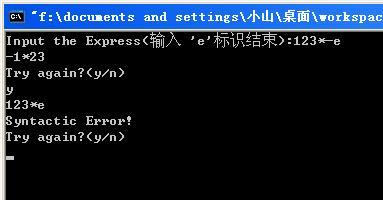??? 這是嚴蔚敏《數據結構》配套習題冊上的題目:將逆波蘭式轉換成波蘭式,并提示錯誤(作為簡化,只處理"+-*/"和0~9的數字)。
??? 例如:"123*-"轉換成波蘭式為"-1*23"
??? 逆波蘭式"123*-"的表達式樹如下:
???

所以這個轉換過程就是:已知一個二叉樹的后根遍歷序列,求先根遍歷序列。
??? 我的算法是根據后根遍歷的序列構造一個表達式樹,進而先根遍歷此樹獲得波蘭式表達式。
??? 定義了兩個結構體:
struct?Exp{
????char??op;
????Item??lhs;
????Item??rhs;
????Exp(){};
????Exp(char?_op,?Item?_lhs,?Item?_rhs):op(_op),?lhs(_lhs),?rhs(_rhs){?}
????Exp(const?Exp&?e):op(e.op),?lhs(e.lhs),?rhs(e.rhs)?{?}
};
表示一個表達式,也是表達式樹上的一個子樹。
struct?Item{
????char??number;
????shared_ptr<Exp>?pExp;
????bool?isNumber;
????explicit?Item():isNumber(true),?number('0'),?pExp(){????}
????Item(const?Item&?i):number(i.number),?pExp(i.pExp),?isNumber(i.isNumber){?}
};
表示一個節點,它可以是一個數字,或者一個表達式(pExp這里我使用的是boost庫的智能指針shared_ptr,所以編譯的話,需要先安裝boost庫)。
運行的結果如圖:

*輸入時,以'e'表示輸入結束。
完整的代碼和可執行文件點擊這里下載。權當拋磚引玉了,希望有更好算法的同學賜教。
完整的代碼:


 #include?<stack>
#include?<stack>
 #include?<algorithm>
#include?<algorithm>
 #include?<string>
#include?<string>
 #include?<iostream>
#include?<iostream>
 #include?<boost/shared_ptr.hpp>
#include?<boost/shared_ptr.hpp>
 using?namespace?std;
using?namespace?std;
 using?boost::shared_ptr;
using?boost::shared_ptr;

 struct?Exp;
struct?Exp;

 struct?Item
struct?Item {
{
 ????char??number;
????char??number;
 ????shared_ptr<Exp>?pExp;
????shared_ptr<Exp>?pExp;
 ????bool?isNumber;
????bool?isNumber;

 ????explicit?Item():isNumber(true),?number('0'),?pExp()
????explicit?Item():isNumber(true),?number('0'),?pExp() {????}
{????}

 ????Item(const?Item&?i):number(i.number),?pExp(i.pExp),?isNumber(i.isNumber)
????Item(const?Item&?i):number(i.number),?pExp(i.pExp),?isNumber(i.isNumber) {?}
{?}
 };
};


 struct?Exp
struct?Exp {
{
 ????char??op;
????char??op;
 ????Item??lhs;
????Item??lhs;
 ????Item??rhs;
????Item??rhs;

 ????Exp()
????Exp() {};
{};

 ????Exp(char?_op,?Item?_lhs,?Item?_rhs):op(_op),?lhs(_lhs),?rhs(_rhs)
????Exp(char?_op,?Item?_lhs,?Item?_rhs):op(_op),?lhs(_lhs),?rhs(_rhs) {?}
{?}

 ????Exp(const?Exp&?e):op(e.op),?lhs(e.lhs),?rhs(e.rhs)?
????Exp(const?Exp&?e):op(e.op),?lhs(e.lhs),?rhs(e.rhs)? {?}
{?}
 };
};


 class?Error
class?Error {
{
 ????string?info;
????string?info;
 public:
public:

 ????Error(string?_info):info(_info)
????Error(string?_info):info(_info) {?}
{?}

 ????Error():info("")
????Error():info("") {?}
{?}

 ????string?what()
????string?what() {return?info;}???
{return?info;}???
 };
};


 void?printPorland(Exp&?exp)
void?printPorland(Exp&?exp) {
{
 ????cout?<<?exp.op?;
????cout?<<?exp.op?;
 ????if(exp.lhs.isNumber)??cout?<<?exp.lhs.number;
????if(exp.lhs.isNumber)??cout?<<?exp.lhs.number;
 ????else?printPorland(*exp.lhs.pExp);
????else?printPorland(*exp.lhs.pExp);
 ????if(exp.rhs.isNumber)??cout?<<?exp.rhs.number;
????if(exp.rhs.isNumber)??cout?<<?exp.rhs.number;
 ????else?printPorland(*exp.rhs.pExp);
????else?printPorland(*exp.rhs.pExp);
 ????return;
????return;
 }
}

 int?main()
int?main()


 {
{
 ????stack<Item>??ExpStack;
????stack<Item>??ExpStack;
 ????char?tmpChar;
????char?tmpChar;
 ????Item?tmpItem;
????Item?tmpItem;
 ????Item?tmpLhs;
????Item?tmpLhs;
 ????Item?tmpRhs;
????Item?tmpRhs;
 ????string??numbers?=?"0123456789";
????string??numbers?=?"0123456789";
 ????string??operators?=?"+-*/";
????string??operators?=?"+-*/";

 ????cout<<"Input?the?Express(輸入?'e'標識結束):";
????cout<<"Input?the?Express(輸入?'e'標識結束):";

 ????do
????do {
{

 ????try
????try {
{

 ????????while(cin>>tmpChar)
????????while(cin>>tmpChar) {
{
 ????????????if(tmpChar?==?'e')?break;??//e為結束符
????????????if(tmpChar?==?'e')?break;??//e為結束符
 ????????????else?if(find(numbers.begin(),?numbers.end(),??//是一個數字
????????????else?if(find(numbers.begin(),?numbers.end(),??//是一個數字

 ????????????????????tmpChar)!=numbers.end())
????????????????????tmpChar)!=numbers.end()) {
{
 ????????????????tmpItem.isNumber?=?true;
????????????????tmpItem.isNumber?=?true;
 ????????????????tmpItem.number???=?tmpChar;
????????????????tmpItem.number???=?tmpChar;
 ????????????????ExpStack.push(tmpItem);//數字入棧
????????????????ExpStack.push(tmpItem);//數字入棧

 ????????????}else?if(find(operators.begin(),?operators.end(),?//是一個操作符
????????????}else?if(find(operators.begin(),?operators.end(),?//是一個操作符

 ????????????????????tmpChar)!=operators.end())
????????????????????tmpChar)!=operators.end()) {
{
 ????????????????//操作符每次要對應兩個被操作數,否則語法錯誤
????????????????//操作符每次要對應兩個被操作數,否則語法錯誤
 ????????????????if(ExpStack.size()<2)?throw?Error("Syntactic?Error!");?
????????????????if(ExpStack.size()<2)?throw?Error("Syntactic?Error!");?

 ????????????????//操作符兩邊的元素出棧
????????????????//操作符兩邊的元素出棧
 ????????????????tmpRhs?=?ExpStack.top();
????????????????tmpRhs?=?ExpStack.top();
 ????????????????ExpStack.pop();
????????????????ExpStack.pop();
 ????????????????tmpLhs?=?ExpStack.top();
????????????????tmpLhs?=?ExpStack.top();
 ????????????????ExpStack.pop();
????????????????ExpStack.pop();

 ????????????????tmpItem.isNumber?=?false;???//非數字,是一個表達式
????????????????tmpItem.isNumber?=?false;???//非數字,是一個表達式
 ????????????????tmpItem.pExp?=?shared_ptr<Exp>(new?Exp(tmpChar,?tmpLhs,?tmpRhs));?
????????????????tmpItem.pExp?=?shared_ptr<Exp>(new?Exp(tmpChar,?tmpLhs,?tmpRhs));?

 ????????????????ExpStack.push(tmpItem);?????//表達式入棧
????????????????ExpStack.push(tmpItem);?????//表達式入棧
 ???????????????????????????
???????????????????????????

 ????????????}else?
????????????}else? {??//?未知字符
{??//?未知字符
 ????????????????throw??Error("Unknow?Character!");
????????????????throw??Error("Unknow?Character!");
 ????????????}
????????????}
 ????????}
????????}

 ????????if(ExpStack.size()!=1)?throw?Error("Syntactic?Error!");
????????if(ExpStack.size()!=1)?throw?Error("Syntactic?Error!");

 ????????tmpItem?=?ExpStack.top();
????????tmpItem?=?ExpStack.top();
 ????????ExpStack.pop();
????????ExpStack.pop();

 ????????if(tmpItem.isNumber)?cout?<<?tmpItem.number?<<endl;
????????if(tmpItem.isNumber)?cout?<<?tmpItem.number?<<endl;
 ????????else?printPorland(*tmpItem.pExp);
????????else?printPorland(*tmpItem.pExp);
 ????????cout?<<?endl;
????????cout?<<?endl;


 ????}catch(Error&?e)
????}catch(Error&?e) {
{
 ????????cout?<<?e.what()?<<?endl;
????????cout?<<?e.what()?<<?endl;
 ????????getline(cin,?string());????????//跳過錯誤的當前行
????????getline(cin,?string());????????//跳過錯誤的當前行
 ????}
????}

 ????????cout?<<?"Try?again?(y/n)"?<<?endl;
????????cout?<<?"Try?again?(y/n)"?<<?endl;
 ????????cin?>>?tmpChar;
????????cin?>>?tmpChar;
 ????}while(tmpChar?==?'y'?||?tmpChar?==?'Y');
????}while(tmpChar?==?'y'?||?tmpChar?==?'Y');
 ????
????
 ????return?0;
????return?0;
 }
}

posted on 2006-12-05 14:45
小山日志 閱讀(2202)
評論(0) 編輯 收藏 引用 所屬分類:
Aha! Algorithm!